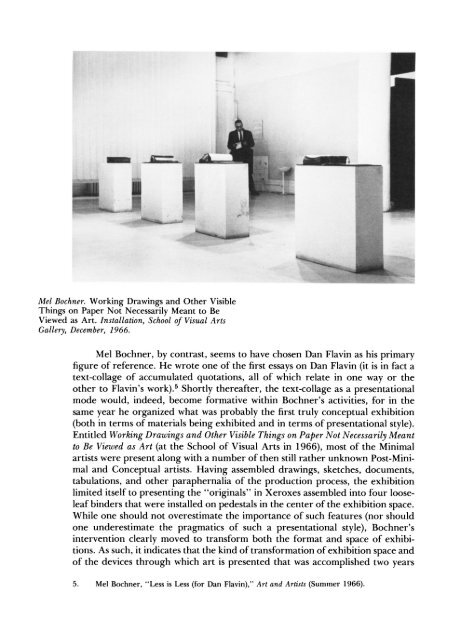Buchloh, conceptual art.pdf - Course Materials Repository
Buchloh, conceptual art.pdf - Course Materials Repository
Buchloh, conceptual art.pdf - Course Materials Repository
Create successful ePaper yourself
Turn your PDF publications into a flip-book with our unique Google optimized e-Paper software.
Zi:?iiii;.:riiiii-iiiiii:-ii-_iii'i<br />
!i~ili!!!!!!!ii!!<br />
:: :::::::: ::: :::::: ..:<br />
Mel Bochner. Working Drawings and Other Visible<br />
Things on Paper Not Necessarily Meant to Be<br />
Viewed as Art. Installation, School of Visual Arts<br />
Gallery, December, 1966.<br />
......<br />
-I7<br />
Mel Bochner, by contrast, seems to have chosen Dan Flavin as his primary<br />
figure of reference. He wrote one of the first essays on Dan Flavin (it is in fact a<br />
text-collage of accumulated quotations, all of which relate in one way or the<br />
other to Flavin's work).5 Shortly thereafter, the text-collage as a presentational<br />
mode would, indeed, become formative within Bochner's activities, for in the<br />
same year he organized what was probably the first truly <strong>conceptual</strong> exhibition<br />
(both in terms of materials being exhibited and in terms of presentational style).<br />
Entitled Working Drawings and Other Visible Things on Paper Not Necessarily Meant<br />
to Be Viewed as Art (at the School of Visual Arts in 1966), most of the Minimal<br />
<strong>art</strong>ists were present along with a number of then still rather unknown Post-Minimal<br />
and Conceptual <strong>art</strong>ists. Having assembled drawings, sketches, documents,<br />
tabulations, and other paraphernalia of the production process, the exhibition<br />
limited itself to presenting the "originals" in Xeroxes assembled into four looseleaf<br />
binders that were installed on pedestals in the center of the exhibition space.<br />
While one should not overestimate the importance of such features (nor should<br />
one underestimate the pragmatics of such a presentational style), Bochner's<br />
intervention clearly moved to transform both the format and space of exhibitions.<br />
As such, it indicates that the kind of transformation of exhibition space and<br />
of the devices through which <strong>art</strong> is presented that was accomplished two years<br />
5. Mel Bochner, "Less is Less (for Dan Flavin)," Art and Artists<br />
(Summer 1966).
















